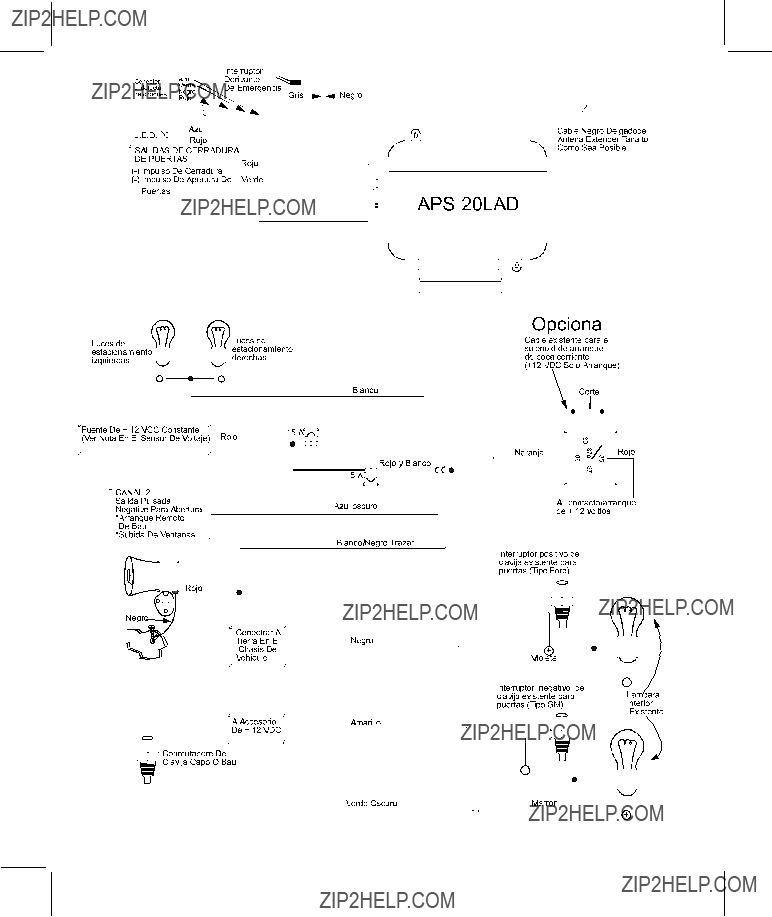diferente en el arn??s. Cada uno de estos portafusibles sostiene un fusible ATC, uno de 5A y otro de 15A. Este cable ROJO debe ser conectado a un cable de energ??a constante del arn??s o de la caja de fusibles del interruptor de encendido del veh??culo. La mayor??a de los veh??culos tiene por lo menos un cable proveniente de la bater??a que suministra energ??a el??ctrica al interruptor de encendido.
Ubique un cable de alimentaci??n el??ctrica constante o un punto de bifurcaci??n en el arn??s o en la caja de fusibles del interruptor de encendido del veh??culo. Este cable tendr?? una lectura constante de +12 V CC, independientemente de la posici??n de la llave de encendido. Empalme y adhiera el cable ROJO del arn??s a este punto.
Cable AMARILLO: Cable de entrada de encendido
Este cable suministra al sistema APS-20LAD la entrada de energ??a el??ctrica de encendido proveniente del veh??culo. Conecte este cable al cable primario de encendido del interruptor de encendido. Este cable tendr?? +12 V CC cuando la llave de contacto se coloca en las posiciones "ON" o "RUN" (encendido) y "START" o "CRANK" (arranque), y 0 V CC cuando la llave de contacto est?? en las posiciones "OFF" (apagado) y "ACCESSORY" (accesorios).
Ubique un cable de energ??a de encendido en el arn??s del interruptor de encendido del veh??culo. Empalme y adhiera el cable AMARILLO del sistema a este punto.
Cable BLANCO: Cable positivo del destellador de las luces de estacionamiento
Este cable tiene el prop??sito de suministrar una salida positiva de +12 V CC al destellador de las luces de estacionamiento, conducidos por el rel?? interno de APS-20, que se conectar?? directamente al circuito positivo de las luces de estacionamiento del veh??culo.
Una vez que se localiza el punto de alimentaci??n, confirme que todas las luces de estacionamiento del veh??culo se iluminar??n cuando est??n conectadas a +12 V CC.
NOTA: Algunos veh??culos (en su mayor??a los europeos) tienen dos lados separados de luces de estacionamiento, uno derecho y otro izquierdo. Para conectar el sistema de luces de estacionamiento en estos veh??culos debe usar 2 rel??s SPDT o DPST para conectar cada uno de los lados y mantenerlos separados.
Ubique un punto de alimentaci??n de las luces de estacionamiento y conecte el cable BLANCO del sistema a este punto.
Cable MARR??N: Cable de entrada negativa (-) de activaci??n de puertas
Si las luces interiores del veh??culo est??n controladas por interruptores de clavija a tierra de las puertas (la mayor??a de los autom??viles GM, Dodge e importados), se debe conectar el cable marr??n de entrada negativa a uno de los interruptores de clavija de la puerta del veh??culo. En la mayor??a de los casos, tendr?? que conectar solamente a un interruptor de puerta, independientemente de cu??ntas puertas tenga el veh??culo, ya que la mayor??a de los circuitos de iluminaci??n de puertas est??n conectados en paralelo. En los pocos casos que no es as??, es necesario conectar a la luz del techo o a cada cable del interruptor de puerta por separado.
Ubique el cable negativo del interruptor de puertas del veh??culo en el panel inferior, debajo del tablero de instrumentos o en el conmutador de clavija del veh??culo. Empalme y adhiera el cable MARR??N del sistema a este punto.
Cable VIOLETA: Cable de entrada positiva (+) de activaci??n de puertas
Si las luces interiores del veh??culo est??n controladas por interruptores de clavija +12 V CC (positivos) de las puertas (la mayor??a de los autom??viles Ford), se debe conectar el cable violeta de entrada positiva a uno de los interruptores de clavija de la puerta del veh??culo. En la mayor??a de los casos, tendr?? que conectar solamente a un interruptor de puerta, independientemente de cu??ntas puertas tenga el veh??culo, ya que la mayor??a de los circuitos de iluminaci??n de puertas est??n conectados en paralelo. En los pocos casos que no es as??, es necesario conectar a la luz del techo o a cada cable del interruptor de puerta por separado. Ubique el cable positivo del interruptor de puertas del veh??culo en el panel inferior, debajo del tablero de instrumentos o en el interruptor de clavija del veh??culo. Empalme y adhiera el cable VIOLETA del sistema a este punto.
Cable VERDE OSCURO: Cable de entrada negativa (-) de activaci??n del cap?? / ba??l
Esta entrada tiene el prop??sito de conectar al interruptor de clavija a tierra del cap??, del ba??l o de la puerta trasera, para permitir disparar el sistema cuando uno de estos lugares de acceso ha sido violado. En el cap??, debe conectar este cable negativo al interruptor de clavija que viene instalado de f??brica del cap?? (si tiene) o a un interruptor de clavija instalado posteriormente. En el ba??l o la puerta trasera debe conectarlo al interruptor de clavija que viene instalado de f??brica del ba??l o de la puerta trasera que controla el circuito de luces del ba??l o puerta trasera.
En los casos donde tanto el punto de entrada del cap?? como del ba??l o puerta trasera se conectan con el cable verde oscuro, se deben usar diodos de aislamiento para prevenir el flujo de corriente que encender??a la luz interior del cap?? cuando se abre el ba??l o puerta trasera, y viceversa. Si se conecta s??lo el cap??, o el ba??l / puerta trasera al cable verde oscuro, el diodo no es necesario.
Nota: Los diodos que pueden ser necesarios para algunas instalaciones son los comunes de la serie 1N4000. Puede usar cualquiera de los diodos de esta serie, siendo los tipos 1N4003 y 1N4007 los m??s comunes. Los diodos deben ser instalados cuidadosamente teniendo en cuenta las direcciones del flujo de corriente.
Nota: Este cable se derivar?? cuando se acceda al canal 2 del control remoto (desenganche del ba??l). Este cable quedar?? derivado mientras haya una conexi??n a tierra y durante 5 segundos despu??s de que se quite la conexi??n a tierra. Esto permite al operador abrir el ba??l por medio de un transmisor remoto sin tener que desactivar primero el sistema de la alarma.
Cable BLANCO Y NEGRO: Cable de salida de la sirena
Este cable suministra una salida positiva (m??ximo 3A) en forma directa a una sirena electr??nica est??ndar. Busque un lugar apropiado para la sirena y m??ntela correctamente. Pase el cable rojo de la sirena del compartimento de pasajero al APS-20LAD. Conecte el cable blanco y negro con el rojo de la sirena. Fije el cable negro de la sirena a una conexi??n a tierra del chasis.
3















